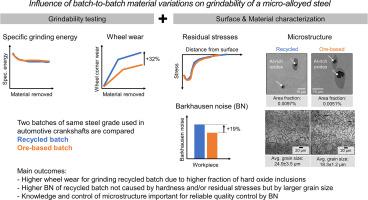Journal of Manufacturing Processes ( IF 6.1 ) Pub Date : 2021-11-23 , DOI: 10.1016/j.jmapro.2021.11.012 Philipp Hoier 1 , Bahman Azarhoushang 2 , Per Lundin 3 , Amir Malakizadi 1 , Jeffrey Badger 4 , Albin Stormvinter 5 , Thomas Björk 6 , Uta Klement 1 , Fukuo Hashimoto 7 , Peter Krajnik 1

|
This study addresses the influence of material variations on the grindability of crankshaft steel. Most previous studies on the effect of material microstructure on grindability involve comparisons of significantly different steel grades. This study, in contrast, is focused on batch-to-batch grindability variations for one steel grade, a scenario frequently occurring in industry where batches from different steel makers are fed into a production line. For this purpose, a batch made of recycled steel and a batch made of ore-based steel were compared with regards to microstructure and grindability under identical grinding and dressing conditions. Although both batches met the same material specifications, microstructural variations were identified in terms of grain size and micro-constituents (inclusions, carbonitrides). While specific grinding energy, residual stress and full-width at half-maximum profiles of ground surfaces were the same for both batches, the recycled batch showed different and unfavorable variation in wheel wear and Barkhausen noise (BN) response. Larger fractions of oxide inclusions and larger grain sizes (affected by carbonitrides) were present in the recycled batch, which were the likely reasons for the differences in wheel wear and BN response, respectively. These findings may aid grindability improvement by steel-grade adjustments, e.g. modification of the distribution and type of inclusions and/or amount of elements forming carbonitrides. Furthermore, the results highlight the importance of understanding and controlling material microstructure, as existing in-line quality by BN control may not always be able to correctly indicate surface integrity, which could lead to misinterpretations (e.g. false part-rejection on the assumption of grinding burn).
中文翻译:

批次间材料差异对中碳钢可磨性的影响
该研究解决了材料变化对曲轴钢可磨性的影响。以前关于材料微观结构对可磨性影响的大多数研究都涉及对显着不同钢种的比较。相比之下,这项研究侧重于一个钢种的批次间可磨性变化,这种情况在工业中经常发生,来自不同钢铁制造商的批次被送入生产线。为此,在相同的研磨和修整条件下,比较了一批由回收钢制成的批次和一批由矿石钢制成的批次的微观结构和可磨性。尽管两个批次都符合相同的材料规格,但在晶粒尺寸和微成分(夹杂物、碳氮化物)方面发现了微观结构差异。虽然两个批次的特定磨削能量、残余应力和磨削表面半峰全宽相同,但回收批次在车轮磨损和巴克豪森噪声 (BN) 响应方面表现出不同且不利的变化。回收批次中存在较大比例的氧化物夹杂物和较大的晶粒尺寸(受碳氮化物影响),这分别是车轮磨损和 BN 响应差异的可能原因。这些发现可能有助于通过调整钢种来改善可磨性,例如改变夹杂物的分布和类型和/或形成碳氮化物的元素的数量。此外,结果强调了理解和控制材料微观结构的重要性,











































 京公网安备 11010802027423号
京公网安备 11010802027423号